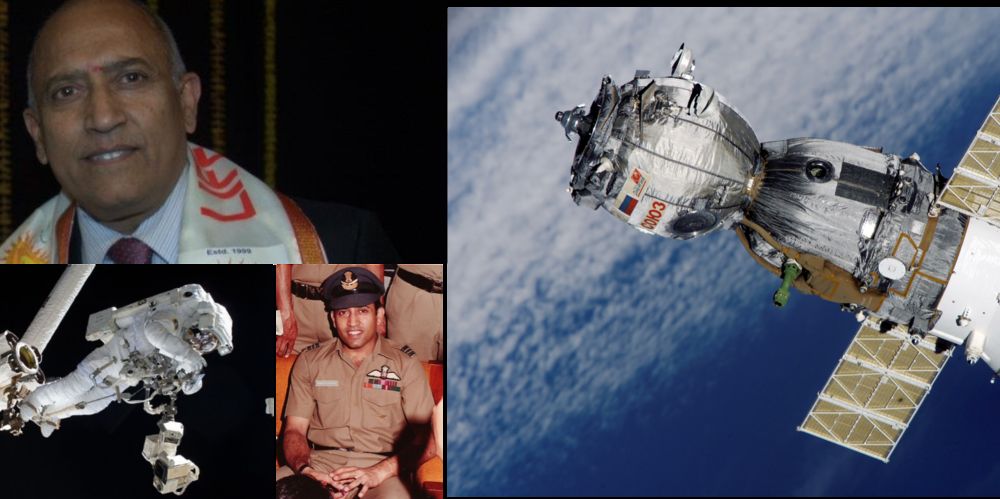
Rakesh Sharma: India’s First Spaceman
Wing Commander Rakesh Sharma ( Then Squadron Leader), Ashok Chakra, Hero of the Soviet Union, created history on 2nd April, 1984 when he became the first Indian Spaceman to be launched into the space. By doing so, he inspired a whole generation and truly launched India in to the 21st Century. Rakesh Sharma is a former Indian Air Force test pilot who flew combat missions in 1971 India – Pakistan war, when he was barely 21 year old. He was launched into space from then U.S.S.R. (Russia) under the Intercosmos programme, aboard Soyuz T-11 spacecraft, on April 2, 1984. He remained in space for about a week after this spacecraft docked with the Salyut 7 Orbital Space Station. Profile: Rakesh Sharma was born in a middleclass family on 13 January 1949 in Patiala, Punjab, India. His father worked in Punjab National Bank. Rakesh attended St. Georges Grammar School, Hyderabad, as his father was posted there. He grew up in Hyderabad and graduated from Nizam College. He was admitted to the National Defence Academy in 35th batch as an Air Force cadet in July 1966 Indian Air Force Career: By 1970, he was commissioned into the Indian Air Force as a test pilot. Rakesh flew various types of aircraft including Mikoyan-Gurevich (MiG) series and climbed through ranks to be Squadron Leader. On 20th September, 1982, Rakesh was selected to become a cosmonaut ( spaceman) for going into space under a joint program between the Indian Space Research Organisation (ISRO) and the Soviet Intercosmos space program, along with Wing Commander Ravish Malhotra. Both of them were sent to Russia for training. Space Mission: Eventually, Rakesh was selected after successful training and was part of the Indo- Russian space crew team member in 1984. Then, he became the first Indian citizen to enter space when he was launched aboard the Soviet rocket Soyuz T-11 from Baikonur Cosmodrome in Kazakh Soviet Socialist Republic on 2nd April 1984. Later, Rakesh spent 7 days 21 hours and 40 minutes aboard the Salyut 7 Orbital Space Station. He conducted scientific and technical studies in the fields of bio-medicine and remote sensing. While the space crew held a joint television news conference with officials in Moscow and then Indian Prime Minister Indira Gandhi asked Rakesh how India looked from outer space, he replied ‘ Saare Jahan Se Achcha’ (the best in the world). This reply and his bold and fearless attitude along with the professional approach with international space crew, his mastery on Russian, English and Hindi languages made him a true hero. That time, India became the 14th nation in the world to send a man into outer space, while Rakesh Sharma personally was 128th man in world who went to space. Awards and Later Life: For this historical feat, Rakesh was conferred with highest peace time award Ashok Chakra by India. Not only this, the USSR also awarded him with ‘ Hero of Soviet Union’ medal. Rakesh resumed his duties as a pilot in frontline fighter squadron in India, after successful space mission. He retired with the rank of Wing Commander. Later, he served as Chief Test Pilot in the Hindustan Aeronautics Limited (HAL) Nashik Division. Further, he moved to Bangalore as a the Chief Test Pilot of HAL. He was involved in the indigenous Light Combat Aircraft Tejas development. He also worked for ISRO as advisor for various Indian space missions including Chandrayan. Family life Rakesh and his wife Madhu are blessed with son Kapil who is a film director and daughter Kritika, who is a media artist. Madhu too learned Russian language while in that country in 1982-84. Wg Cdr Rakesh Sharma ( Retd) is active as a philanthropist and guides the young generation on positive life skills. This lone Indian Spaceman will surely inspire generations of young Indians to come.
